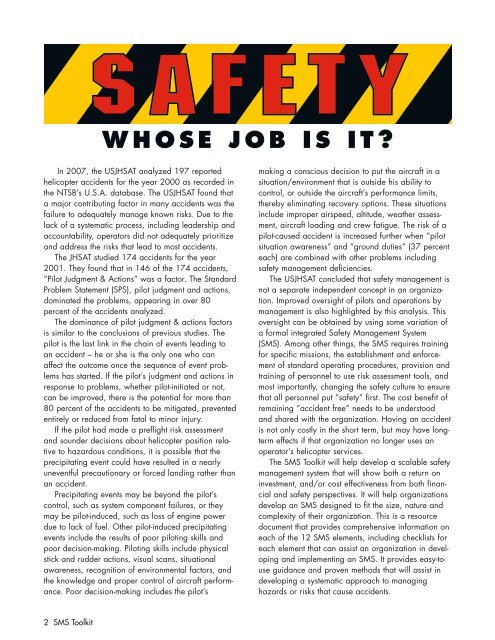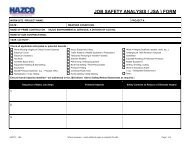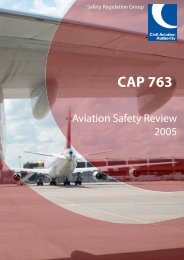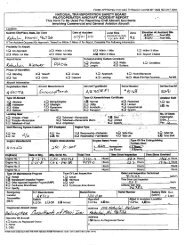International Helicopter Safety Team Safety Management System Toolkit
IHST - Safety Management Toolkit - Skybrary
IHST - Safety Management Toolkit - Skybrary
- No tags were found...
Create successful ePaper yourself
Turn your PDF publications into a flip-book with our unique Google optimized e-Paper software.
WHOSE JOB IS IT?<br />
In 2007, the USJHSAT analyzed 197 reported<br />
helicopter accidents for the year 2000 as recorded in<br />
the NTSB’s U.S.A. database. The USJHSAT found that<br />
a major contributing factor in many accidents was the<br />
failure to adequately manage known risks. Due to the<br />
lack of a systematic process, including leadership and<br />
accountability, operators did not adequately prioritize<br />
and address the risks that lead to most accidents.<br />
The JHSAT studied 174 accidents for the year<br />
2001. They found that in 146 of the 174 accidents,<br />
“Pilot Judgment & Actions” was a factor. The Standard<br />
Problem Statement (SPS), pilot judgment and actions,<br />
dominated the problems, appearing in over 80<br />
percent of the accidents analyzed.<br />
The dominance of pilot judgment & actions factors<br />
is similar to the conclusions of previous studies. The<br />
pilot is the last link in the chain of events leading to<br />
an accident – he or she is the only one who can<br />
affect the outcome once the sequence of event problems<br />
has started. If the pilot’s judgment and actions in<br />
response to problems, whether pilot-initiated or not,<br />
can be improved, there is the potential for more than<br />
80 percent of the accidents to be mitigated, prevented<br />
entirely or reduced from fatal to minor injury.<br />
If the pilot had made a preflight risk assessment<br />
and sounder decisions about helicopter position relative<br />
to hazardous conditions, it is possible that the<br />
precipitating event could have resulted in a nearly<br />
uneventful precautionary or forced landing rather than<br />
an accident.<br />
Precipitating events may be beyond the pilot’s<br />
control, such as system component failures, or they<br />
may be pilot-induced, such as loss of engine power<br />
due to lack of fuel. Other pilot-induced precipitating<br />
events include the results of poor piloting skills and<br />
poor decision-making. Piloting skills include physical<br />
stick and rudder actions, visual scans, situational<br />
awareness, recognition of environmental factors, and<br />
the knowledge and proper control of aircraft performance.<br />
Poor decision-making includes the pilot’s<br />
making a conscious decision to put the aircraft in a<br />
situation/environment that is outside his ability to<br />
control, or outside the aircraft’s performance limits,<br />
thereby eliminating recovery options. These situations<br />
include improper airspeed, altitude, weather assessment,<br />
aircraft loading and crew fatigue. The risk of a<br />
pilot-caused accident is increased further when “pilot<br />
situation awareness” and “ground duties” (37 percent<br />
each) are combined with other problems including<br />
safety management deficiencies.<br />
The USJHSAT concluded that safety management is<br />
not a separate independent concept in an organization.<br />
Improved oversight of pilots and operations by<br />
management is also highlighted by this analysis. This<br />
oversight can be obtained by using some variation of<br />
a formal integrated <strong>Safety</strong> <strong>Management</strong> <strong>System</strong><br />
(SMS). Among other things, the SMS requires training<br />
for specific missions, the establishment and enforcement<br />
of standard operating procedures, provision and<br />
training of personnel to use risk assessment tools, and<br />
most importantly, changing the safety culture to ensure<br />
that all personnel put “safety” first. The cost benefit of<br />
remaining “accident free” needs to be understood<br />
and shared with the organization. Having an accident<br />
is not only costly in the short term, but may have longterm<br />
effects if that organization no longer uses an<br />
operator’s helicopter services.<br />
The SMS <strong>Toolkit</strong> will help develop a scalable safety<br />
management system that will show both a return on<br />
investment, and/or cost effectiveness from both financial<br />
and safety perspectives. It will help organizations<br />
develop an SMS designed to fit the size, nature and<br />
complexity of their organization. This is a resource<br />
document that provides comprehensive information on<br />
each of the 12 SMS elements, including checklists for<br />
each element that can assist an organization in developing<br />
and implementing an SMS. It provides easy-touse<br />
guidance and proven methods that will assist in<br />
developing a systematic approach to managing<br />
hazards or risks that cause accidents.<br />
2 SMS <strong>Toolkit</strong>







